Parent Category:
Reward comes when preparation meets opportunity
A trained eye knows to look for the carriage of the head, neck, back and spinal column which should appear as a gentle curve moving forward with no waste of motion.
Part I discusses the structure of canines when they are standing. Part II focuses on structure and how to evaluate it when a dog is in motion. To begin this discussion we can say that good structure is necessary for humans and canines. Those that have legs that are bowed - out or bowed - inward or a spine that is curved are likely to suffer health problems. While there are many differences between humans and canines, good body structure is common to both. Understanding the differences between dogs and breeds begins with one of the key skills required of breeders and judges. It starts with a breeds history, function and purpose. When taken together, these elements help explain structural variations, shapes and sizes. For example, those that herd and hunt usually travel over long distances. The length of body and leg for these breeds will not be the same as those whose function and purpose requires speed.
Movement
The ability to recognize correct and incorrect movement is an essential element of dog knowledge. Therefore, it is important to know what correct structure looks like when standing and in motion. Said another way, canine movement requires an understanding of the coordinated structure, especially in the front and the rear assemblies.
In this regard, one of the key elements of movement involves how dogs put their feet down as they move their body forward. Correct movement depends on the basic principles of good structure which is determined in part by nature ,but generally speaking, effortless movement is good movement, and every dog attempts to move forward with the least amount of effort. Experts have long believed that the better dogs, when gaiting, will have more extension of their front and rear feet and when coupled with a balanced body, will produce more efficient movement. Therefore, anything that detracts from efficient movement is generally considered a fault. In evaluating the faults and virtues of dogs in motion one can find many variations in the degree of severity and the frequency of their occurrences. In this regard, faults will vary from dog to dog and from breed to breed. Some faults can more easily be detected when dogs are in motion. Unfortunately, movement is often quicker than the eye can follow and in the confined space and limited time allowed in the show ring, evaluations are sometimes far from ideal. But the educated eye, that is, the eye that knows what to look for, will not be easily misled. In the show ring, judges and breeders have developed a trained eye which knows to look for the carriage of the head, neck, back and spinal column. They should appear as a gentle curve moving forward with no waste of motion as seen in Figure 1. Those who evaluate movement have learned to appreciate the differences between breeds and the many ways they move.
Figure 1. Head carriage, neck, back and spinal column - appear as a gentle curve
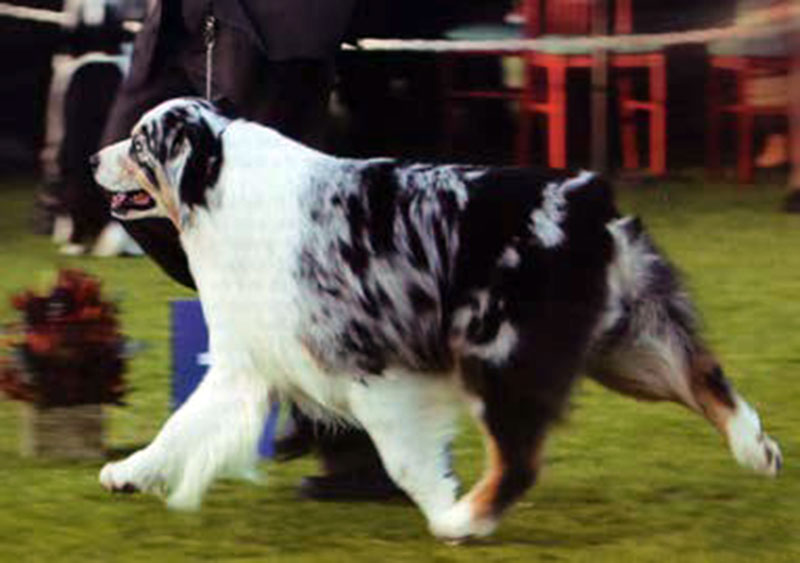
Figure 1a. Head carriage, neck, back and spinal column - appear as a gentle curve
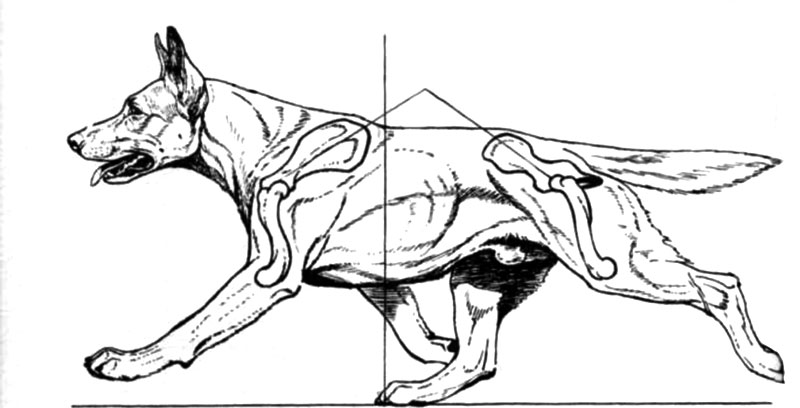
Since all breeds do not move alike it is necessary to learn about their structural differences. The Bull dog with its massive front does not move like the wolfhound with its long legs and muscular body or the Beshone with its stylish gait and dignity of head carriage. But no matter the breed, big or small they all attempt to move forward with the least amount of effort regardless of the individual quirks man has bred into them.
The dynamics of motion impose certain tendencies on all dogs. When they move from a walk to a trot the sequence of their feet changes. When walking three feet are on the ground supporting the dog as one foot moves forward. This is seen as the sequential movement of the legs. The right front foot and then the left rear foot and so forth. As movement increases from a walk to a trot, the front and rear legs tend to fall almost on a straight line in order to maintain balance. This causes the legs to converge towards a center line as speed increases. This movement is called the tendency to single track. Height and length of leg influences this tendency which will be discussed later.
Three Principles of Movement
Movement experts and judges evaluate movement in the show ring three ways, from the side, going and coming. These are the traditional techniques used to reveal the faults and virtues of a dog’s gait. The diagonal carpet in the show ring is used by the judge to evaluate key parts of the front and rear assemblies when the dog is moving away from and towards the judge. Evaluating the front and rear assemblies begin with three principles of movement. The first is called a straight column of support. This means that the leg assembly forms a single column of support from the hip joint or shoulder to the ground (Figure 2).
Figure 2 Single Column of Support
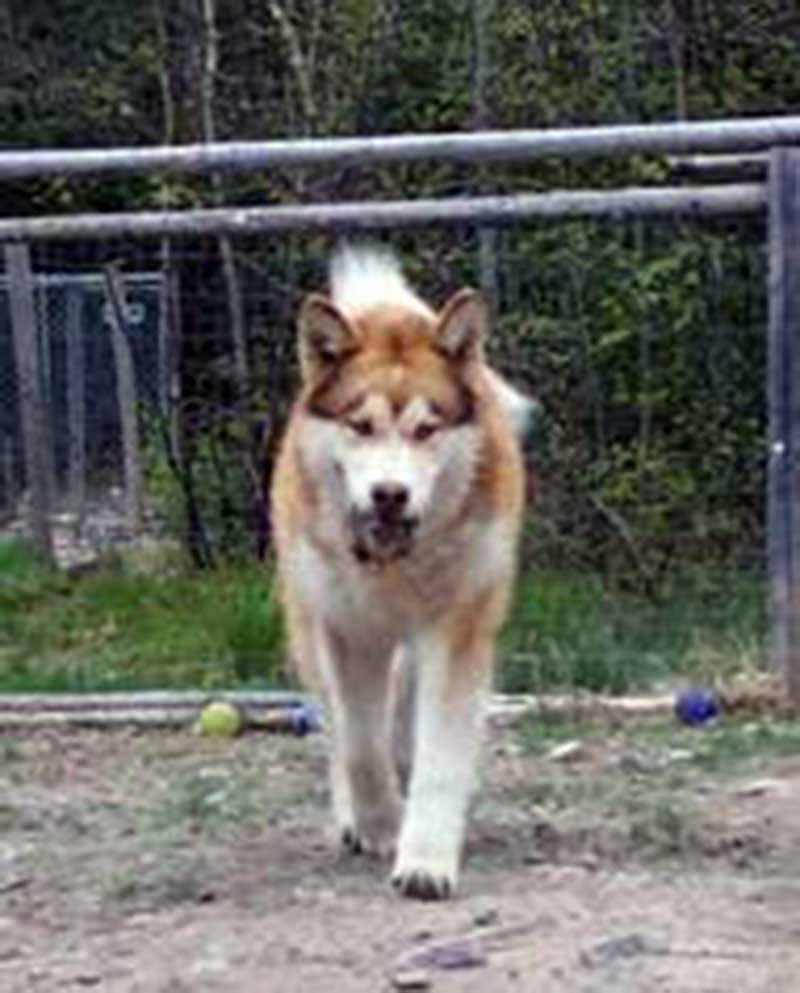
Any deviation from the single column of support is faulty. This does not mean perpendicular legs, but a straight line from the shoulder to the pad. When faculty movement is noted the cause can be related to several conditions such as loose shoulders, twisting hocks or cow hocks.
The second principle is called the parallel movement of the legs on the same side of the body. This concept involves the coordination of the front and rear assemblies. They should move in parallel planes. As the dog moves toward the judge the front leg on one side of the body should obscure the rear leg on the same side of the body. This is called moving in the same planes (Figure 3). During the down and back exercise the judge looks to see if the hind foot strikes in almost the same place as the front foot on the same side of the body. Dogs that are not able to align their legs in parallel planes generally have structural faults. The most common is called "crabbing" or "sidewinding" as seen in Figure 6. An example of how this principle occurs away from the show ring can be seen when an automobile is moving in the snow. While the vehicle has four wheels, it only leaves two tire tracks in the snow because the front and rear tires are traveling in the same plane. Puppies that have this problem of alignment often trip and fall. By the time most pups are adults they have learned not to trip themselves by moving their front feet to one side (crab or sidewind) and avoid falling. In the show ring, judges use the diagonal runner and the down and back exercise to look for the first and second principles of movement (Figure 5 & 6). Crabbing has many causes such as height to length or the rear assembly that has more angulation than the front assembly or poor extension in front combined with a stiff back causing too much drive from behind. Because there is more than one reason for crabbing or sidewinding, one should be careful when assigning a cause for it. Figure 3 shows a Corgi that does not single track but does have legs that travel in the same plane. Figure 4, shows a dog that single tracks while traveling in the same plane.
Figure 3. Traveling in the same plane
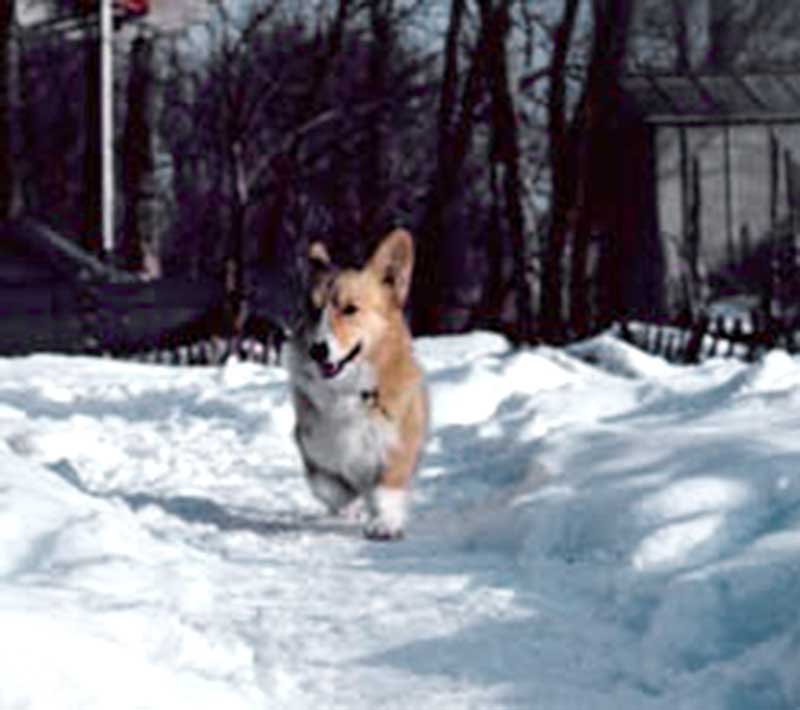
Figure 4. Traveling in the same plane
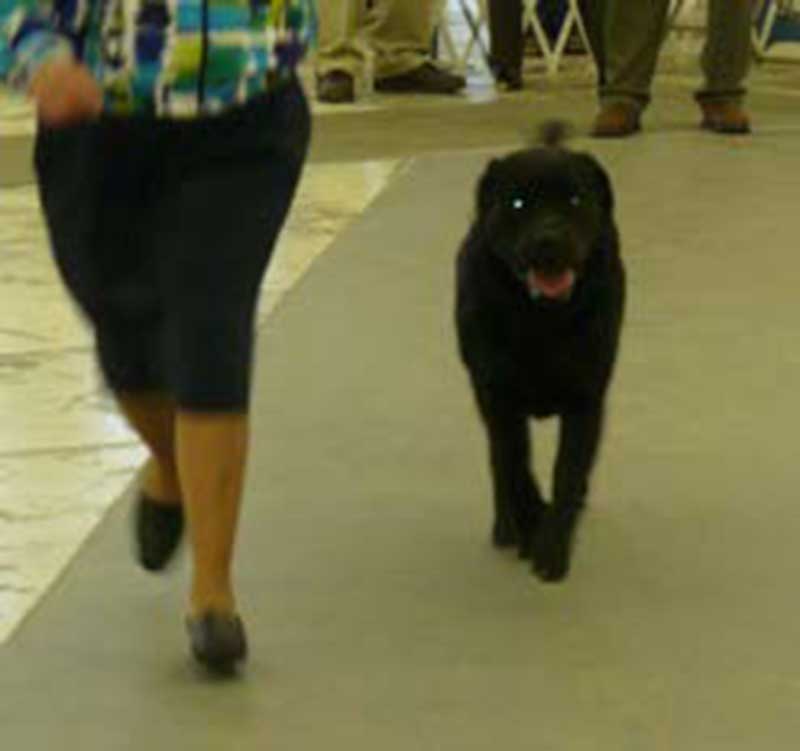
There are other variations of movement involving the front and rear legs. For example, some dogs will single track with their front feet and move wide apart with their rear feet.
Sometimes this movement is reversed. Figure 5 shows a dog that single tracks while traveling in the same plane. Of all the faults of alignment, Figure 6 illustrates the most noticeable fault called crabbing or sidewinding.
Figure 5. Single Track
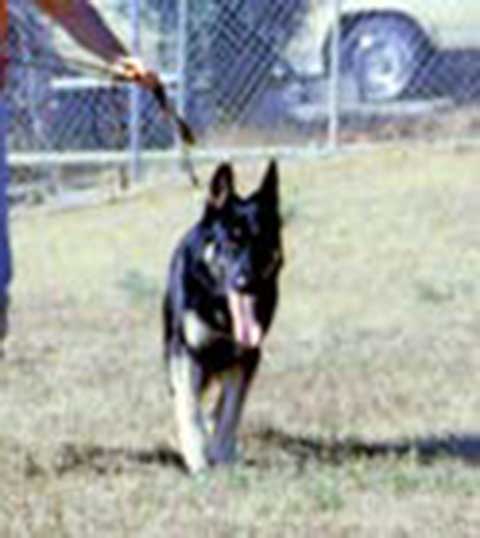
Figure 6. Side wind or Crabbing *
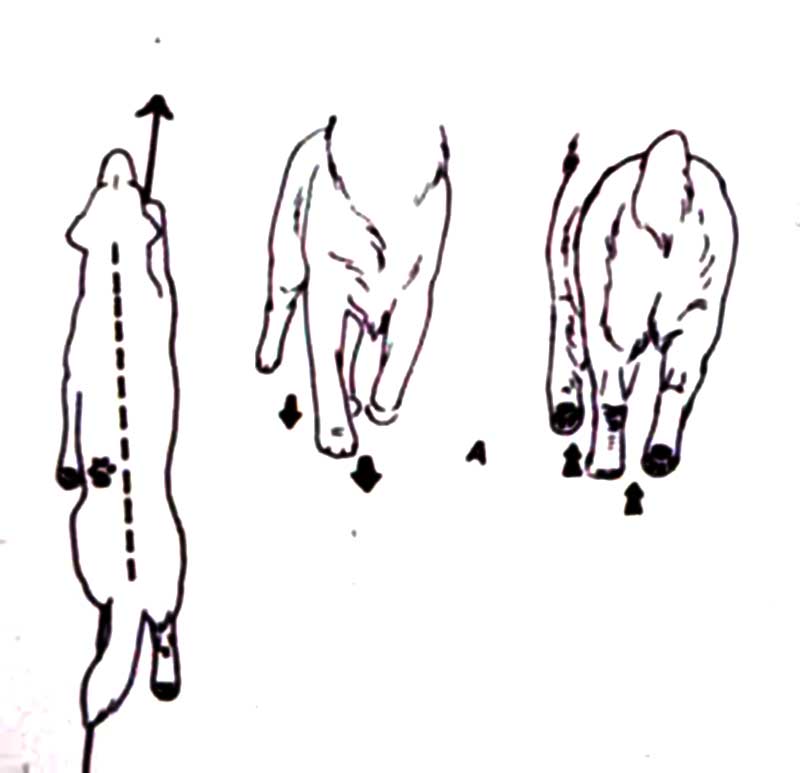
Trot and Pace
The trot and the pace are both two- beat gaits. The trot is the most common gait. It is a two- beat diagonal gait causing the front and rear feet to touch the ground together. The right hind, left front, left front, right hind, and so on. Because only two feet touch the ground at any time, the dog relies on forward movement to maintain balance with the hind feet following along the track left by the front feet. In the flying trot, which is characteristic of the German Shepherd Dog, all four feet are off the ground for a brief period of time. It is a faster gait then the trot but not as fast as the gallop in which the dog hurdles all of its feet off the ground at the same time. When a dog paces, both legs on one side of the body move as a pair. It is a lateral gait and considered to be incorrect in the American show ring. The pace is influenced by the relative height of the shoulder to the length of the body. A dog too short for its height tends to pace. But the pace can also be the result of an injury or fatigue. Therefore, one needs to be careful when assigning a cause for the pace.
The third principle of movement focuses on the rear hocks. When standing, they should appear to be straight and parallel and underneath the hip sockets. Imagine the rear hocks as two short and straight columns of support that are parallel to each other and set just slightly outside the hip sockets as seen in Figure 6. Dogs that have cow hocks (Figure 7) do not move with efficiency and will tire more easily when they gait.
Figure 7. Hocks, Straight and Parallel *
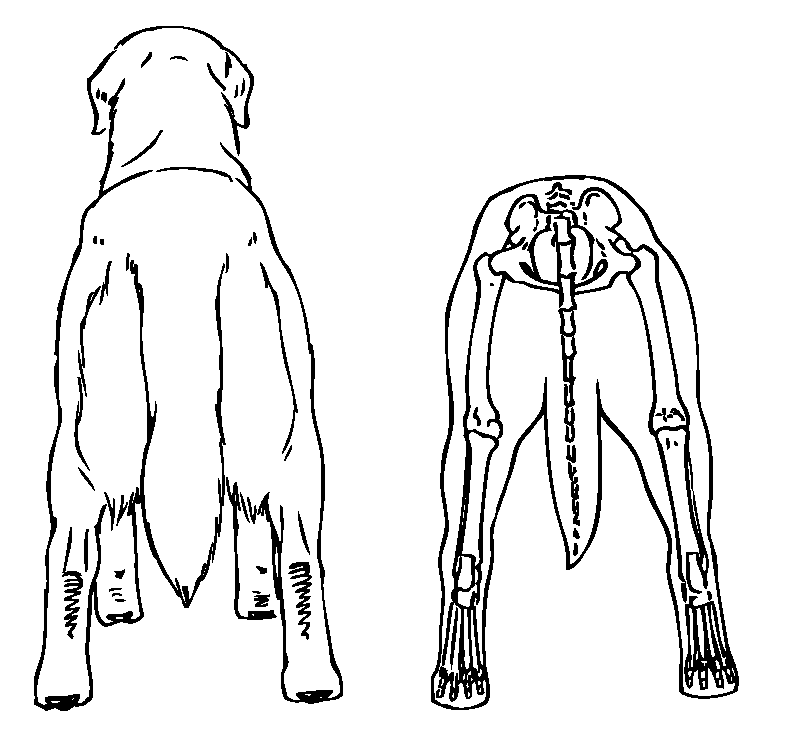
Figure 8. Cow Hocks
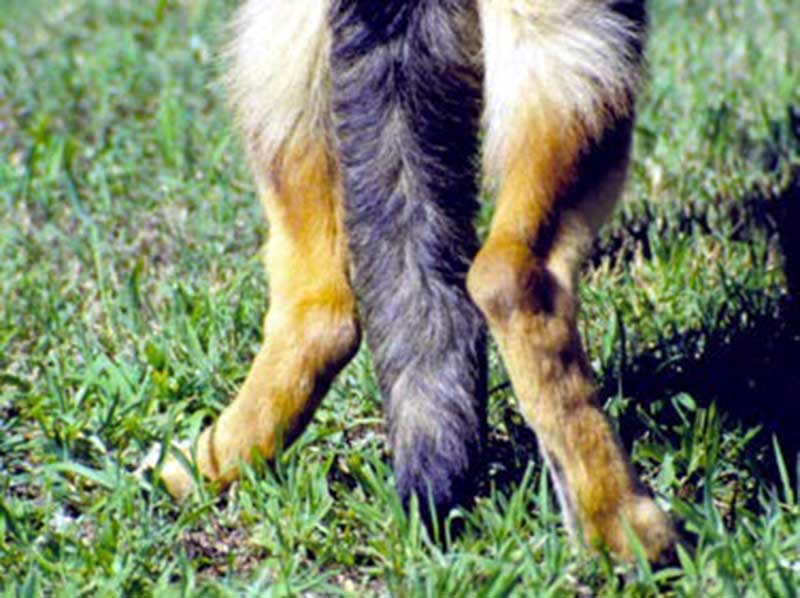
Figure 9 illustrates five variations of the rear legs and how they might appear in motion. Many breeds have long coats which makes seeing the hocks more difficult. In these breeds the recommendation is to look at the pads of the rear feet rather than the hocks while the dog is in motion. Notice the direction they are pointing.
Figure 9. The rear pads point in different directions *
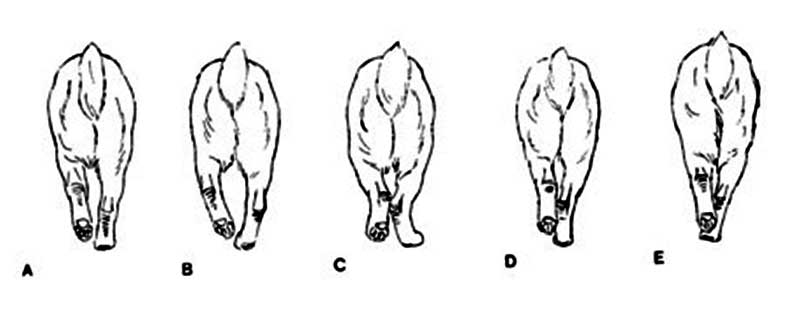
Observing dogs in motion can also be complicated by the restrictions placed on the dog by the handler. Generally a dog and handler are considered a team but too frequently, through intent or lack of attention, a handler can confuse a dog’s movement with the lead. Under these conditions, it is not possible to evaluate movement when the lead is tight or when the lead is used to lift the front feet up so they barely touch the ground.
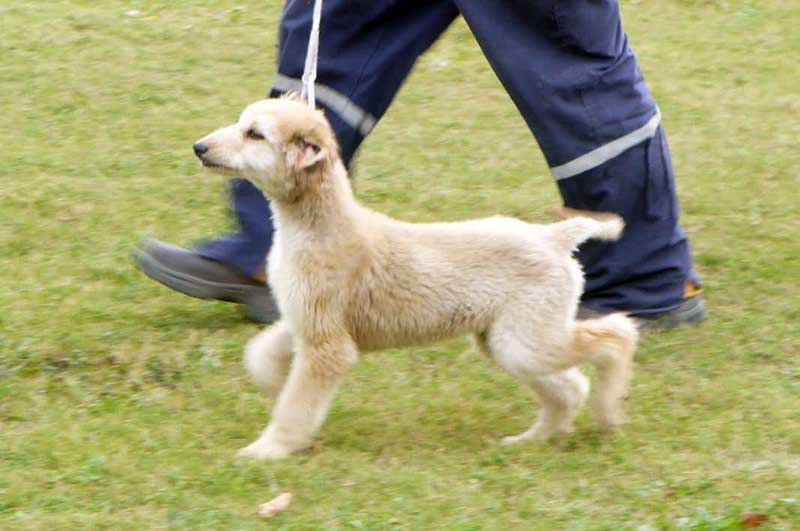
Under these conditions structure and movement cannot be adequately evaluated.
Motion Study
Pictures, diagrams and illustrations help in our understanding of structure when a dog is standing because most of the body parts are easy to see. When dogs are in motion other factors influence what can be seen. For example, a dog’s general health, a past injury, habit, or the effects of aging all complicate structural analysis and movement evaluations. In order to better understand these problems, Jones (2013) studied some of the subtle traits that can easily mislead an observer. Using detection - trained police dogs, Jones studied the early behavior and movement of lumbosacral disease in working dogs. This problem was selected for two reasons. First, the disease was found to be a problem in high-drive working dogs who often mask their clinical signs. Second, Lumbosacral disease was selected because it is an important cause of disability and premature retirement in working dogs (Linn et al 2003). By the time pain is evident and the faults of movement obvious, the disease has advanced. In order to learn more about structure and movement problems early in their development, two motion analysis experts, a 3-D motion digital camera and a canine body suit with sensors were used to capture and record joint and leg movements. This study used three detection- trained police dogs. Dog #1 was a four –year- old male German Shepherd Dog trained for detection and patrol duties. Dog #2 was a four- year- old male Labrador Retriever trained for detection duties. Dog #3 was a four year old male Blood Hound trained for search and rescue duties. The use of high- tech equipment coupled with the observations by experts would appear to be straight- forward except for the dogs. For Dog #1, the body suit was well tolerated however; the dog became over- heated quickly and required frequent rest periods. For dog #2, the markers on the body suit appeared to distract the dog and the dog repeatedly stopped during the test and tried to remove the suit. For dog #3, the markers did not appear to be a distraction however loose skin movement over the joints caused inaccuracies in some observations and in data collection.
This study serves as a good reminder that even when experts used high- tech equipment and data analysis, they still encountered unexpected problems. A closer look at what occurred shows that understanding movement in the controlled environment of a laboratory is not always simple or obvious because there are many body parts in motion and dogs will often change directions and move at different speeds. Similar diagnostic problems can occur in the clinical setting of a veterinarian’s office or in the show ring. Radio graphs, palpations and sonograms are often used to identify and diagnose conditions of the joints, muscles, tendons and ligaments. While these technical protocols can rule out some problems, they do not explain a dog’s genetics or why a dog’s movement is correct or incorrect. In the show ring, judges face similar problems which require them to rely on experience, breed knowledge, ring procedure and skill in their effort to evaluate structure when dogs are standing and while they are in motion.
Conclusion
In the Jones study, high- tech equipment and movement experts evaluated structure in motion in the early stages of a disease when the most common symptoms are subtle changes in movement. Under these conditions dogs will often mask their symptoms which can mislead evaluations. For example, when movement is less than smooth or when there is a reluctance to perform a simple task for which the dog has been trained, such as walking or trotting, structural faults can be misleading. For example, evaluating dogs that are searching high places, jumping into vehicles or onto obstacles, climbing stairs and bite work is similar to the animated movement seen at agility, obedience and field trials, but not the same as the movement on the flat surfaces of the show ring. What this study uncovers is that a dog’s general health, a past injury, habit or the effects of aging all complicate the results of structural analysis and movement evaluations. These subtle and often unnoticed factors can mislead even the educated eye. This study demonstrates that movement under the best conditions can be misleading and sometimes deceptive. For these reasons evaluations in the show ring that require gaiting and the extension of the front and rear leg assemblies can become complicated when different speeds are involved.
The information presented in these two papers shows that the decision about structure and movement will oftentimes vary between judges, breeders and exhibitors. The lack of information and poor ring procedure sometimes influence decisions. Therefore, movement should always be evaluated at different speeds and more than once. Thus, we should not be surprised when in the less technical world of breeders, owners and judges the placements and rankings in the show ring will vary between and among the recognized experts.
Note: * Illustrations by Marcia R. Schlehr
References
Battaglia, Carmen, 2014. Do you see what I see? Canine Chronicle, Ocala, Fl. April pp. 106-108. Battaglia, Carmen. 2008. More than meets the eye. Canine Chronicle, Ocala, Fl., pp. 300 302
Brackett, Lloyd, and Hartwell, Laurence A., "The Dog in Motion", Dog World Magazine, (USA) August 1961- October 1965
Elliot, Rachel Page, Dog steps, 2001. A New Look, Third Edition, Doral Publishing, Sun City, Arizona, pg. 68 -73
Gilbert, Edward M., & Brown, Thelma R., Structure and Terminology, Howell Book House NY, 1995
Jenkins, Farish A., Jr. The Movement of the Shoulder in the Claviculate and Aclaviculate Mammals, Department of Biology, Museum of Comparative Zoology, Harvard university, Cambridge, MA
Lyon, McDowell, 1950. The Dog in Action, Howell Book House, NY, NY.
Gilbert, E, and Gilbert, P., Encyclopedia of K-9 Terminology. 2013. Dogwise Publications, Wenatchee, WA.
Jones, J, Tucker, T., Tan, J., Pierce, B., Foxworth, J, Long, B., Harper, T., Morens, D. 2013. Improving understanding of early behavioral indicators of lumbosacral disease in working dogs using 3D visualization of skeletal movement during working task: Feasibility study, J. Beh., 8, pp. 309-315. Linn, 2003.
About the Author
Carmen L Battaglia holds a Ph.D. and Masters Degree from Florida State University. As an AKC judge, researcher and writer, he has been a leader in promotion of breeding better dogs and has written many articles and several books.Dr. Battaglia is also a popular TV and radio talk show speaker. His seminars on breeding dogs, selecting sires and choosing puppies have been well received by the breed clubs all over the country.

